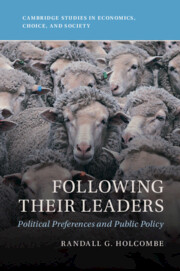Book contents
- Following Their Leaders
- Cambridge Studies in Economics, Choice, and Society
- Following Their Leaders
- Copyright page
- Dedication
- Contents
- Figures
- Tables
- Preface
- 1 Introduction
- 2 Instrumental and Expressive Voting
- 3 Influences over Preference Formation
- 4 Preference Aggregation through Voting
- 5 The Formation of Political Preferences
- 6 Anchor Preferences and Derivative Preferences
- 7 Preferences of Elites and Masses
- 8 Policies That Maximize Political Power
- 9 Patriotism, Propaganda, and the Public Interest
- 10 Implications for Democracy
- References
- Index
5 - The Formation of Political Preferences
Published online by Cambridge University Press: 16 March 2023
- Following Their Leaders
- Cambridge Studies in Economics, Choice, and Society
- Following Their Leaders
- Copyright page
- Dedication
- Contents
- Figures
- Tables
- Preface
- 1 Introduction
- 2 Instrumental and Expressive Voting
- 3 Influences over Preference Formation
- 4 Preference Aggregation through Voting
- 5 The Formation of Political Preferences
- 6 Anchor Preferences and Derivative Preferences
- 7 Preferences of Elites and Masses
- 8 Policies That Maximize Political Power
- 9 Patriotism, Propaganda, and the Public Interest
- 10 Implications for Democracy
- References
- Index
Summary
The well-established concept of expressive voting concludes that the public policy preferences people express are likely to differ from their instrumental preferences, but the literature on expressive voting has not developed clear conclusions about how people form their expressive preferences. An extensive literature on preference formation helps to answer this question. Because there are no instrumental consequences from the political preferences citizens hold, the utility they get from those preferences comes solely from their having and expressing them. People have a status quo bias, and are prone to value the preferences they have because of the endowment effect. People adopt preferences to minimize cognitive dissonance, and often yield to peer pressure when choosing the public policy preferences they express. There is a bandwagon effect, and people’s policy preferences are affected by the mass media. This chapter goes beyond just saying that expressive preferences differ from instrumental preferences by explaining why they differ.
Keywords
- Type
- Chapter
- Information
- Following Their LeadersPolitical Preferences and Public Policy, pp. 72 - 95Publisher: Cambridge University PressPrint publication year: 2023

